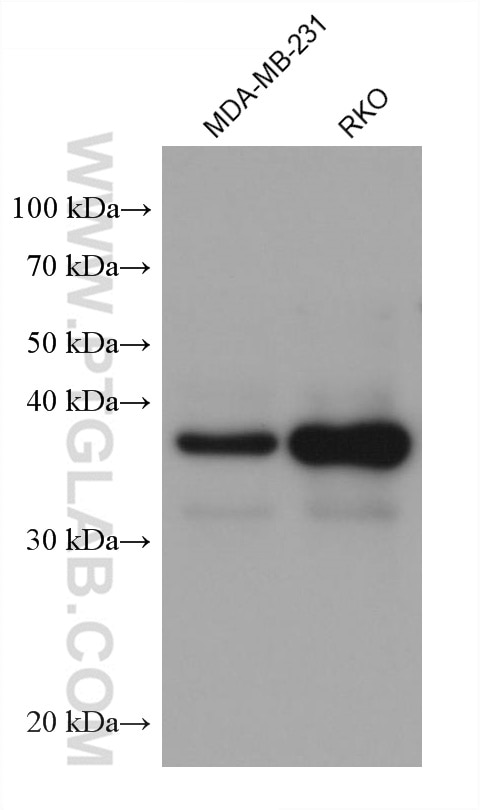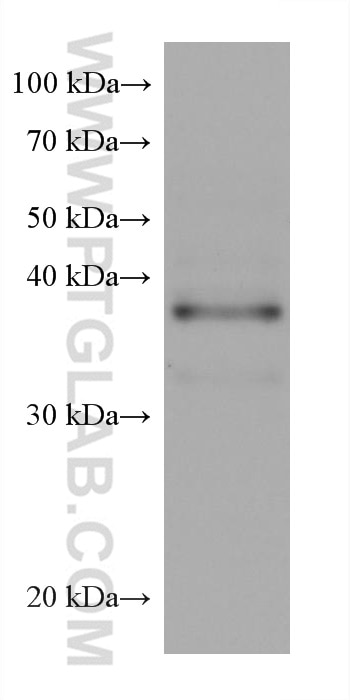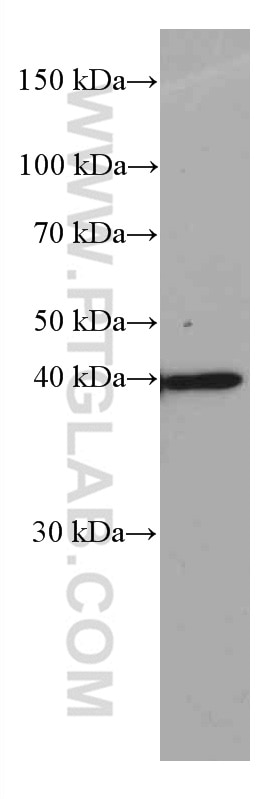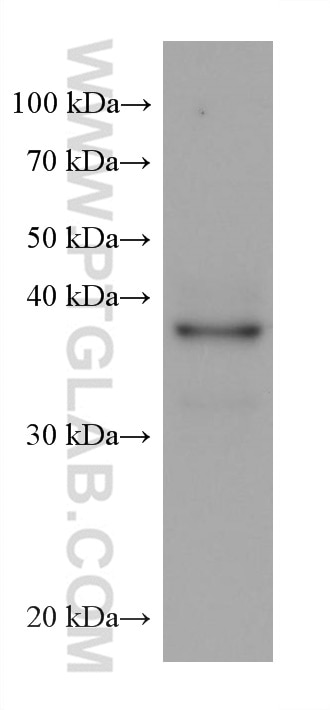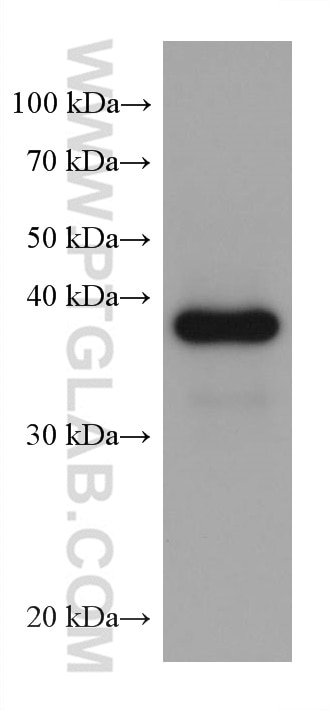Validation Data Gallery
Tested Applications
| Positive WB detected in | MDA-MB-231 cells, ROS1728 cells, Saos-2 cells, HEK-293 cells, NIH/3T3 cells, RKO cells |
Recommended dilution
| Application | Dilution |
|---|---|
| Western Blot (WB) | WB : 1:5000-1:50000 |
| It is recommended that this reagent should be titrated in each testing system to obtain optimal results. | |
| Sample-dependent, Check data in validation data gallery. | |
Published Applications
| KD/KO | See 1 publications below |
| WB | See 26 publications below |
Product Information
66313-1-Ig targets JUN in WB, ELISA applications and shows reactivity with human, mouse, rat samples.
| Tested Reactivity | human, mouse, rat |
| Cited Reactivity | human, mouse, rat |
| Host / Isotype | Mouse / IgG1 |
| Class | Monoclonal |
| Type | Antibody |
| Immunogen | JUN fusion protein Ag17639 相同性解析による交差性が予測される生物種 |
| Full Name | jun oncogene |
| Calculated molecular weight | 331 aa, 36 kDa |
| Observed molecular weight | 39 kDa |
| GenBank accession number | BC068522 |
| Gene Symbol | JUN |
| Gene ID (NCBI) | 3725 |
| RRID | AB_2881694 |
| Conjugate | Unconjugated |
| Form | Liquid |
| Purification Method | Protein A purification |
| UNIPROT ID | P05412 |
| Storage Buffer | PBS with 0.02% sodium azide and 50% glycerol , pH 7.3 |
| Storage Conditions | Store at -20°C. Stable for one year after shipment. Aliquoting is unnecessary for -20oC storage. |
Background Information
What is the molecular weight of JUN?
The molecular weight of JUN is approximately 39 kDa.
What is the cellular localization of JUN?
JUN expression can be located in the nucleus. However, ubiquitinated JUN colocalizes with lysosomal proteins (PMID: 15469925).
What is the function of JUN?
JUN is a basic leucine zipper (bZIP) transcription factor that recognizes and binds to a consensus heptamer motif of 5'-TGA[CG]TCA-3' in the enhancer region of target genes. JUN acts as either a homo- or heterodimer and binds to the DNA to regulate transcriptional activity, specifically promoting the activity of NR5A1 when phosphorylated by HIPK3, leading to increased steroidogenic gene expression upon the stimulation of the cAMP signaling pathway (PMID: 9732876).
What post-translational modifications is JUN subjected to?
JUN is acetylated at Lys-271 by EP300 (PMID: 11689449). JUN is phosphorylated by PLK3 following exposure to hypoxia or UV irradiation, which leads to increased DNA-binding activity (PMID: 27281822), and also by PAK2 at numerous threonine residues to promote cell proliferation and transformation (PMID: 21177766). JUN is also phosphorylated by DYRK2 at Ser-243, which primes it for subsequent further phosphorylation by GSK3B and reduces its ability to bind DNA (PMID: 22307329).
What is the role of JUN in disease?
Activation of JUN is linked with proliferation and angiogenesis in invasive breast cancers (PMID: 16733206).
Protocols
| Product Specific Protocols | |
|---|---|
| WB protocol for JUN antibody 66313-1-Ig | Download protocol |
| Standard Protocols | |
|---|---|
| Click here to view our Standard Protocols |
Publications
| Species | Application | Title |
|---|---|---|
Cell Biol Toxicol microRNA-149-5p mediates the PM2.5-induced inflammatory response by targeting TAB2 via MAPK and NF-κB signaling pathways in vivo and in vitro. | ||
Genomics Integrative epigenomic profiling reveal AP-1 is a key regulator in intrahepatich cholangiocarcinoma. | ||
Pharmacol Res CX-5461 is a potent immunosuppressant which inhibits T cell-mediated alloimmunity via p53-DUSP5. | ||
J Cell Physiol Lack of Mof reduces acute liver injury by enhancing transcriptional activation of Igf1. | ||
Front Pharmacol Azithromycin Attenuates Bleomycin-Induced Pulmonary Fibrosis Partly by Inhibiting the Expression of LOX and LOXL-2. |
